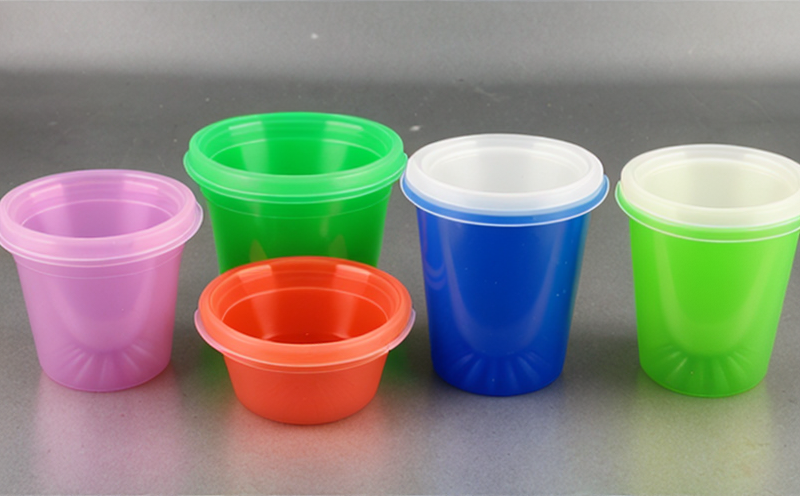EN ISO 22088 Stress Cracking Testing of Disposable Plastics
The stress cracking phenomenon is a critical concern in the design and development of disposable plastics. This condition can lead to unexpected failures, particularly under cyclic loading conditions such as those experienced during normal use or storage. The EN ISO 22088 standard provides a standardized method for evaluating the susceptibility of plastic materials to stress cracking when exposed to specific environmental factors.
The test procedure involves subjecting specimens to a defined load and temperature, followed by immersion in a solvent. Specimens are then dried and observed over time for signs of cracking or failure. This testing is particularly important for ensuring the reliability and safety of disposable plastics used in medical devices, food packaging, consumer goods, and other applications where durability under stress is crucial.
The standard's methodology ensures consistency across different laboratories and helps manufacturers to identify potential weaknesses early in the design process. By adhering to this protocol, companies can minimize the risk of product failures that could lead to safety issues or costly recalls. This testing also supports regulatory compliance for markets with stringent requirements on material durability.
Understanding the stress cracking behavior allows engineers and quality assurance teams to optimize materials and processes. For instance, by identifying critical points in the design lifecycle, manufacturers can make informed decisions about polymer blends, additives, and processing conditions that enhance resistance to stress cracking.
The test results provide valuable insights into material performance under real-world conditions. This is particularly important for disposables where the end-user may subject the product to multiple loading cycles or storage in various environments. The data generated can also be used in lifecycle assessments, helping companies understand the environmental impact and durability of their products.
Moreover, stress cracking testing aligns with broader sustainability goals by promoting the development of more robust materials that are less likely to contribute to waste through premature failure. This is especially relevant for single-use plastics where reducing unnecessary disposal can have a significant positive environmental impact.
The methodology specified in EN ISO 22088 ensures that testing laboratories follow stringent procedures, which helps maintain high standards of accuracy and reliability. This standardization is crucial for ensuring comparability of results across different studies and locations. It also supports the development of industry best practices and contributes to the overall improvement of product quality.
In summary, stress cracking testing under EN ISO 22088 provides essential information on material performance that is critical for the design and manufacture of safe, reliable, and environmentally responsible disposable plastics.
Benefits
The benefits of conducting EN ISO 22088 stress cracking testing are multifaceted, encompassing both technical and operational advantages:
- Informed Design Decisions: Understanding the stress cracking behavior allows for more informed design decisions, leading to products that are inherently safer and more reliable.
- Predictive Performance: The testing provides a predictive measure of how materials will perform under real-world conditions, enhancing confidence in product durability.
- Risk Mitigation: By identifying potential weaknesses early in the development process, companies can mitigate risks associated with product failures, which could lead to safety issues or costly recalls.
- Regulatory Compliance: The test ensures compliance with international standards, facilitating market entry into regions with stringent regulatory requirements.
- Sustainability: Stress cracking testing supports the development of more robust materials that are less likely to contribute to waste through premature failure, thereby promoting sustainability goals.
- Enhanced Customer Trust: Demonstrating adherence to international standards builds trust with customers and stakeholders, enhancing brand reputation.
- Operational Efficiency: By minimizing the risk of product failures in the field, companies can reduce operational costs associated with warranty claims and service calls.
Why Choose This Test
Selecting EN ISO 22088 stress cracking testing is a strategic choice for organizations looking to ensure the durability, reliability, and safety of their disposable plastics. Here are several reasons why this test should be part of your quality assurance process:
- Consistency Across Laboratories: The standardized methodology ensures consistent results across different laboratories, enhancing the credibility of the testing.
- Comprehensive Evaluation: This test evaluates materials under conditions that closely mimic real-world use, providing a comprehensive assessment of their durability and reliability.
- Advanced Materials Development: By identifying critical points in the design lifecycle, this test supports the development of advanced materials that can withstand stress cracking.
- Regulatory Assurance: The test aligns with international standards, ensuring compliance with regulatory requirements and facilitating market entry into regions with stringent regulations.
- Sustainability Focus: Stress cracking testing helps in the development of more robust materials that are less likely to contribute to waste through premature failure, supporting broader sustainability goals.
- Customer Satisfaction: Demonstrating adherence to international standards builds trust with customers and stakeholders, enhancing overall customer satisfaction.
Quality and Reliability Assurance
The stress cracking test under EN ISO 22088 is a cornerstone of quality and reliability assurance for disposable plastics. Here’s how it contributes to these objectives:
- Early Detection of Weaknesses: By conducting this test early in the design process, potential weaknesses can be identified and addressed before mass production begins.
- Predictive Testing: The test provides a predictive measure of how materials will perform under real-world conditions, enhancing confidence in product durability.
- Risk Mitigation: Identifying and addressing potential issues early helps mitigate risks associated with product failures, which could lead to safety concerns or costly recalls.
- Consistent Results: The standardized methodology ensures consistent test results across different laboratories, enhancing the credibility of the testing process.
- Sustainability Focus: Stress cracking testing supports the development of more robust materials that are less likely to contribute to waste through premature failure, thereby promoting sustainability goals.
- Operational Efficiency: By minimizing the risk of product failures in the field, companies can reduce operational costs associated with warranty claims and service calls.





